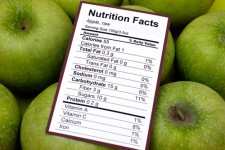 Label for Fresh Apples via Shutterstock
Label for Fresh Apples via Shutterstock
Food labels have been around for years, mandated by the FDA. They show calories, serving size, fat, carbs and some vitamins, etc. Somehow, though, they don't seem to have had an effect on obesity rates, which is one important goal.
Many people have complained that the label is hard to use, causing the agency to provide more guidance on how to use the information to improve health. But not content with the information provided, some in Great Britain have suggested that it might be good to complicate things even further by adding exercise equivalents to labels for packaged foods.
Writing in the BMJ, Dr. Shirley Cramer opines that putting exercise equivalents on food labels might help people balance their energy input with output, and help fight obesity. But how would that work?
The proposal she suggests is adding symbols "showing how many minutes of several different physical activities are equivalent in the calories expended to those in the product." Such labels would apparently be on the front of packaged foods, and show how long it would take a "person of average age and weight" to work off the calories in that food.
So here's the problem — what's an "average age" or an "average weight"? How would a person know? What if you're heavier than some average weight? Would you know that you'd use more calories than someone who is underweight? And what if you're older than average? Would calorie consumption go up or down? Although Dr. Cramer cites studies suggesting that consumers would use activity information to change their behavior, we all know where that good intention-paved road can lead.
Yet another concern is that such labels might influence consumers to focus too much on calorie content, which is certainly important — but not the only important aspect of food labels. Two foods with similar calorie counts could have very different nutritional content — think a full-calorie soft drink compared to an equal amount of orange juice — same calories but very different nutritional profiles.
There hasn't been that much research on what effect such labels would have on what people actually do. One study on menu labels found that parents in fast food restaurants that did, or did not, have activity equivalents on the menus didn't change the number of calories they ordered for their kids. The parents did say such labels could prompt them to encourage their children to exercise more. But again, we have that good intentions-paved road.
Lacking substantial evidence that adding activity equivalents to food labels would have any positive influence on consumer behavior, this is just another idea whose time has yet to come. Complicating labels further is unlikely to have positive impacts on consumers' food choices.



